| Plethodon cinereus Plethodon serratus | |||||||||||
| Redback Salamanders | |||||||||||
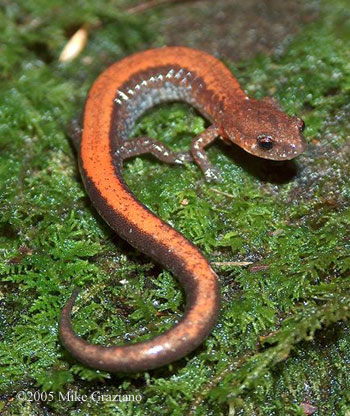
|
|
||||||||||
| Plethodon serratus |
Description
Northern redback salamanders, Plethodon cinereus, are small (6.5-12.5 cm / 2.5 - 4.5 inches), slender woodland salamanders that have two distinct color morphs. The first color morph is the variation from which this species gets its common name. It is characterized by being dark brown to black in ground coloration with a red, orange, or tan dorsal stripe with straight edges extending from the head onto the tail. The belly is mottled with black and white and there are often small flecks and spots of brassy or whitish pigment on the head, back, and sides of the body. The second morph is often called the "leadback" salamander, and lacks a reddish dorsal stripe entirely, being uniformly dark in coloration. Otherwise, it is identical to the first morph in size, shape, and belly coloration. Though one sometimes outnumbers the other, these two morphs usually coexist together in the same populations, and intermediates of the two morphs due to interbreeding can sometimes be found (eg. individuals with incomplete red stripes, random red spots, etc.). Additionally, albinos or erythristic morphs, which are entirely red in coloration, are sometimes found.
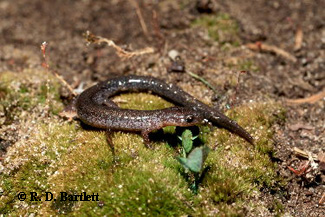 Plethodon cinereus, leadback phase. |
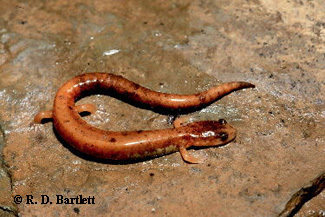 Plethodon cinereus, erythristic morph. |
Southern redback salamanders, Plethodon serratus, tend to be slightly smaller in size (up to 10.5cm) than northern redbacks, but are similar in coloration and there are also two color morphs. The first morph is generally dark brown in coloration with a red or orange stripe extending from the head to the tail. In some populations this stripe has distinctly serrated edges (Arkansas, Louisiana, and Oklahoma), while in other populations the stripe may be straight-edged or only weakly serrated (Alabama, Georgia, Missouri, North Carolina, and Tennessee). There may be small, scattered white spots on the head, back, and sides and the belly is mottled with dark brown and white. The unstriped or "leadback" morph is also identical to the first morph, but lacking the reddish stripe.
Sexually active males can be distinguished from females by the presence of a crescent shaped mental gland under the chin, swollen nasolabial glands (which appear as an enlarged upper lip region), enlarged premaxillary teeth, and hedonic glands on the tail. When out of breeding season, the sexes can be difficult to distinguish. Another recent technique for sexing redback salamanders involves using bright lights to view the sexual organs of the salamanders through the skin, similar to candling an egg.
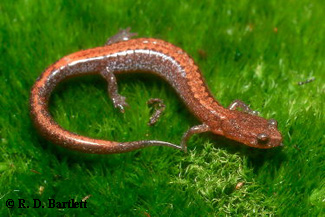 Plethodon serratus, redback phase. |
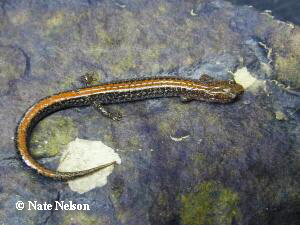 Plethodon serratus, redback phase. |
Natural Range and Habitat
The Northern redback salamander ranges from Southern Quebec, Prince Edward Island, and Nova Scotia south to North Carolina and Tennessee; westward to southwestern Ontario, northeastern Minnesota, Wisconsin, and eastern Illinois. There are also small relict populations in western Minnesota and southeastern North Carolina. Generally they inhabit moist, forest floor habitats with deep soil and abundant forest floor debris. There they hide under all manner of shelter including rocks, logs, leaf litter, and even trash. They avoid soils which are highly acidic, saturated, or have shallow/rocky topsoils. Studies have suggested that while many redbacks can be found on the surface of a given locality, there may be far more individuals living entirely underground which rarely, if ever, come to the surface for extended periods of time.
Southern redback salamanders occur in four distinct, widely separated areas: 1.) The Ouachita Mountains of Arkansas and Oklahoma, 2.) the Salem Plateau of southeastern Missouri, 3.) the Blue Ridge/Piedmont regions of North Carolina, Tennessee, Alabama, and Georgia, 4.) central Louisiana. They occur in similar habitats to northern redbacks but can also be found in drier, rockier ecosystems than their northern relatives.
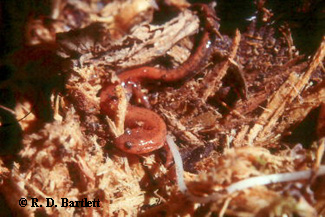 Plethodon cinereus, erythristic morph. |
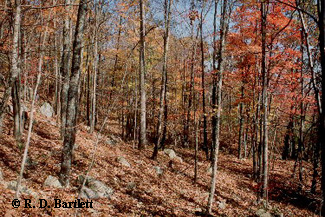 Plethodon cinereus habitat, Amherst County, VA. |
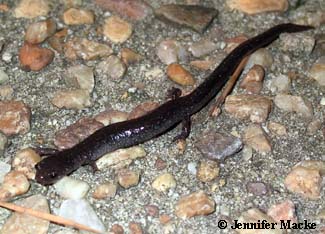 Plethodon cinereus, leadback phase. |
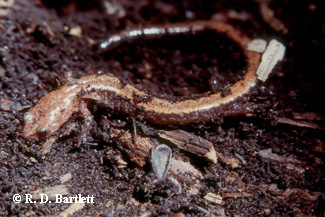 Plethodon cinereus, redback phase, dark specimen. |
Housing
Both species have been documented to be highly territorial both in the wild and in captivity. Males and females actively claim and defend territories and resources from individuals of either sex so one should be mindful of this territoriality when deciding how many individuals to keep in a particular setup. Separate hiding places are a must to avoid needless bullying by larger males and females. I have found that 2 or 3 adults can be easily kept in a 8 X 12 inch (20 X 30cm) plastic container if provided with separate hiding places. Males and females are much more aggressive to other unfamiliar redbacks of either sex.
There are two approaches that can be taken when housing redback salamanders; the complex, aesthetically pleasing setup or the simple, efficient setup. The former entails a terrarium designed to mimic their natural forest habitat complete with soil, potted plants/moss, and hiding places in the form of dead leaves, cork bark, bits of dead wood, etc. The soil should be kept moist, but not saturated or muddy and may be misted daily. This type of setup can be made quite attractive but one should take into account that these salamanders are nocturnal and highly secretive and so will rarely be seen on the surface except at night. The latter setup consists of plastic storage containers with substrates of moist soil, leaf mulch, or damp paper toweling (unbleached). Hiding places such as cork bark or flat stones should also be given for the animals to hide under. This setup is somewhat superior in that individuals can be readily seen and fed and their health can be more readily monitored. Neither setup requires standing water of any kind and these salamanders will never willingly enter water.
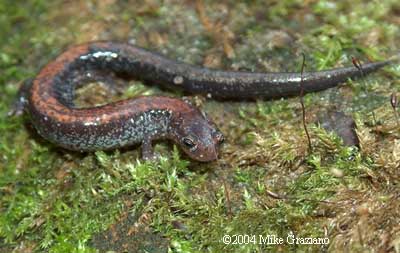
Plethodon cinereus, redback phase.
In both setups, the most important factors are moisture and temperature. Ideally, these salamanders should be kept at 60-68°F / 15-20°C (reduced to mid 50s °F / 8-12°C in winter for proper cycling) to mimic the naturally cool temperatures of shaded, forest leaf litter and all efforts should be made to keep their tanks from reaching 75°F+ / 24°C+. Heat stress is a well-documented cause of death in salamanders and Plethodontids, such as the redbacks, are particularly sensitive to heat. To achieve these temperatures, one might consider keeping them in a basement, next to an air conditioning vent, or a naturally cooler room of the house. Definitely keep them out of direct sunlight, and if plants are to be part of the setup, then fluorescent lighting must be provided. The substrates should be cleaned/changed regularly. Soil substrates can usually be changed every few months, but toweling tends to foul faster and may need to be changed every couple of weeks. It is also important to provide sufficient moisture for the salamanders without making the setup too wet or marshy, which can lead to fungal infections. Also, these salamanders can easily scale glass and plastic, so tight-fitting lids with no gaps are a must! If you feel a medium sized cricket could escape the setup, the chances are your redback could too.
Redback salamanders are occasionally available in the pet trade, but, due to their abundance in the wild, they are more commonly collected from the wild by curious herpers. Before collecting and keeping a redback, be sure to check the relevant laws of the state or province in question.
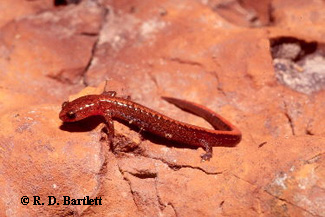 Juvenile Plethodon serratus, redback phase. |
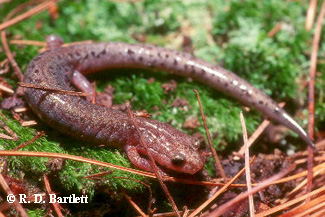 Plethodon serratus, leadback phase. |
Feeding
These little salamanders are surprisingly voracious predators. In the wild they consume virtually any prey that is available and small enough to be captured, including termites, ants, flies, mites, springtails, spiders, earthworms, snails, slugs, centipedes, millipedes, and even the eggs and small juveniles of their own species. In captivity they will eat fruitflies, pinhead crickets, small earthworms, whiteworms, blackworms, small mealworms, and other readily available, suitably sized live foods.
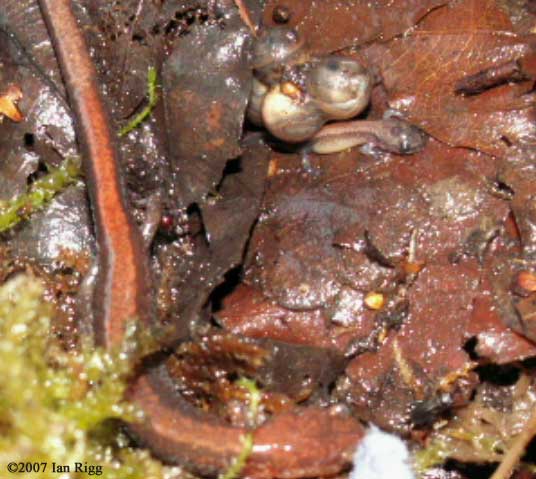
P. cinereus adult with eggs and hatchling.
Breeding
Courtship for P. cinereus generally occurs from autumn to early spring. Males actively seek out females during this time and approach females by bumping noses and arching and undulating their tail. If the female is receptive he will begin rubbing his chin across her back, which causes his enlarged teeth to lightly abrade the skin. This is presumed to facilitate the introduction of pheromones from his mental gland directly into her skin. If she is still receptive, the male positions himself beside her and waits for her to rest her chin on the base of his tail. They then proceed to perform a "tail-straddle walk" where the female closely follows the male with her chin on the base of his tail until he deposits a spermatophore. She then orients herself to pick up the spermatophore in her vent. After successful transfer, they separate and go their separate ways. Females then go to find suitable brooding chambers which are usually in a crevice or chamber underground or within a rotten log. Females can lay up to 14 eggs (3-4 mm in diameter each) which are usually laid in late spring or early summer in grape-like clusters and are suspended from the roof of the chamber by a short pedicel. The female remains coiled around the cluster until hatching, usually about 6 weeks. The young juveniles hatch as fully formed, terrestrial animals (no aquatic larval stage).
P. cinereus kept long term in laboratory situations often breed, and in simple setups similar to those described above in the housing section. In this respect, they are an ideal species for the person interested in witnessing the breeding behavior of a Plethodon species. Some strategies to consider in attempting to breed them include number of males, familiarity, removal of other salamanders after eggs have been laid, and suitable artificial brooding chambers. Males will often disrupt the courtship of other males by attacking and biting, so ideally only one male should be kept with females. Familiarity also plays a key role, as males and females which are familiar with each other are more likely to mate successfully than with unfamiliar individuals. After the laying of eggs, other redbacks will continually try to eat the female's clutch (and hatched juveniles) leading to stress and perhaps abandonment of the eggs. To avoid this, all salamanders but the brooding female should probably be removed. It is also best to disturb the brooding female as little as possible. Brooding chambers can be made by providing artificial crevices such as PVC pipes, upside down water dishes, stacked rocks, coconut hulls, etc.
P. serratus courtship and breeding has not been documented in nearly as much detail, but it is presumed to be very similar to P. cinereus.
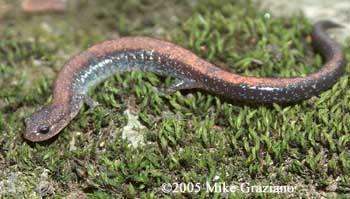 Plethodon cinereus, redback phase. |
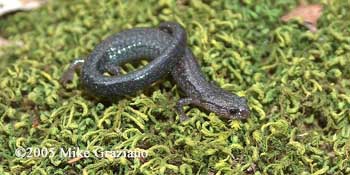 Plethodon cinereus, leadback phase. |
References
Bernardo, Joseph and Stevan J. Arnold. 1999. Mass-rearing of Plethodontid salamander eggs. Amphibia-Reptilia. 20 (2):219-224.
Burton, T. M. . 1976. An analysis of the feeding ecology of the salamanders (Amphibia, Urodela) of the Hubbard Brook Experimental Forest, New Hampshire. . Journal of Herpetology. 10 187-204.
Camp, C. D. . 1988. Aspects of the life history of the southern red-backed salamander Plethodon serratus in the southeastern United States. American Midland Naturalist. 119 93-100.
Davidson, M. and H. Heatwole. 1960. Late summer oviposition in the salamander, Plethodon cinereus. Herpetologica. 16 141-142.
Gabor, Caitlin R.; Jaeger, Robert G.; 1995, Resource
quality affects agonistic behavior of territorial
salamanders, Animal Behavior 49(1):71-79
Gergits, W. F. and R. G. Jaeger. 1990. Field observations of the behavior of the red-backed salamander (Plethodon cinereus): courtship and agonistic interactions. Journal of Herpetology 24: 93-95.
Mathis, A. 1989. Do seasonal spatial patterns in a terrestrial salamander reflect reproductive bahavior or territoriality? Copeia. 1989: 788-791.
Fraser, D. F. 1976. Coexistence of salamanders in the genus Plethodon: A variation of the Sanat Rosalia theme. Ecology. 57 (2):238-251.
Guffey, Cary, James G. Makinster and Robert G. Jaeger. 1998. Familiarity affects interactions between potentially courting territorial salamanders. Copeia. 1998 (1):205-208.
Petranka, James W.; 1998, Salamanders of the United States and Canada, Smithsonian Institute Press, Washington.
Quinn, V.S. and B.M. Graves. 1999. A technique for sexing red-backed salamanders (Plethodon cinereus). Herpetological Review 30:32.
Spotila, J. R. 1972. Role of temperature and water in the ecology of lungless salamanders. Ecological Monographs. 42: 95-125.
© Nate Nelson. Posted August 2002.
